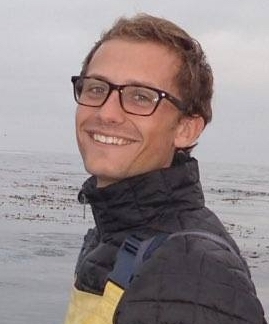Josh Smith
|
Joshua Smith is a Ph.D. Candidate in the Department of Ecology and Evolutionary Biology at the University of California, Santa Cruz. His research explores species interactions that shape the structure and functions of marine communities. Specifically, he focuses on the relationships between habitat features, grazer behavior, and predator-prey dynamics that contribute to underlying organization and resiliency in kelp forest ecosystems. Along with these ecological concepts that he is fascinated by, Josh deeply values academic training, educational research, and mentorship of next generation scientists. Josh plans to become a professor and is completing ISEE’s PDP program to enhance his pedagogical training.
|
 |
Teaching Activity Summary
Name of Teaching Activity: ENVS 104A/L
Teaching Venue: July 3, 2019 at the Coastal Biology Building, UCSC
Learners: 5 undergraduate students.
Reflection on how the activity designed was influenced by research on equity & inclusion in STEM teaching:
Our activity design addressed the development of a science identity in our learners using the science identity frameworks presented in Carlone and Johnson (2007), and Hazari et al. (2013). The development of a science identity in our learners was centered around four key competencies: (1) Competence. We supported the development of scientific competency by giving students time to practice basic scientific skills (e.g., field sampling methods, graphing results, communicating and interpreting findings). The acts of observing patterns in nature, developing hypotheses that explain observed patterns, testing hypotheses, and making claims that are supported by evidence further developed their scientific competency. (2) Performance. We addressed the performance of science by having a group presentation activity, where students presented their research to their peers. (3) Recognition. Peer recognition was achieved through a jigsaw poster session, where students both presented their original research and asked appropriate questions of their peers when visiting other posters. (4) Interest. Having students formulate their own questions allowed them to pursue their own interests. Our teaching venue was comprised of students with a ride range of interests (e.g., pure science, education, and conservation and management). Allowing students to pursue their own questions that fit within the conceptual framework of our activity was key to enhancing student interest.
Through my own teaching experiences, I have learned operational teaching strategies for E&I that I use in the classroom, such as content rubrics that clearly define learning objectives and requirements with students (which helps level prior knowledge so that all students understand they are here to learn to same material), communicating and maintaining high standards for all students, and using a variety of analogues to connect students’ experience with real-world research and to familiarize students with people from diverse backgrounds who are making (or have made) tremendous contributions in STEM. I particularly like to share the story of Rachel Carson, remembered today as the ecologist (before that science was even defined) and writer who challenged the impact of human activities on the natural world. Rachel brought attention to the environmental consequences of bombs, DDT, and chemicals and initiated the contemporary environmental movement.
I have taught many courses as a graduate student and above all, I have learned that it’s not just about what we teach; it’s also about how we teach. Students in our classes come with unique perspectives, values, prior knowledge, and personal STEM motivations that shape the way they learn. My teaching strategies draw from equitable evidence-based teaching methods from the learning sciences to improve student retention rates, persistence, academic achievement, and sense of belonging. My mission is to use these tools to commit to equity and accessibility so that every learner can thrive. As a future faculty member, I intend to build an inclusive research group and to foster a teaching and learning community that supports vibrant intellectual development and learning in next generation scientists.
Carlone, Heidi B., and Angela Johnson. "Understanding the science experiences of successful women of color: Science identity as an analytic lens." Journal of Research in Science Teaching: The Official Journal of the National Association for Research in Science Teaching 44.8 (2007): 1187-1218.
Hazari, Zahra, Philip M. Sadler, and Gerhard Sonnert. "The science identity of college students: Exploring the intersection of gender, race, and ethnicity." Journal of College Science Teaching 42.5 (2013): 82-91.
